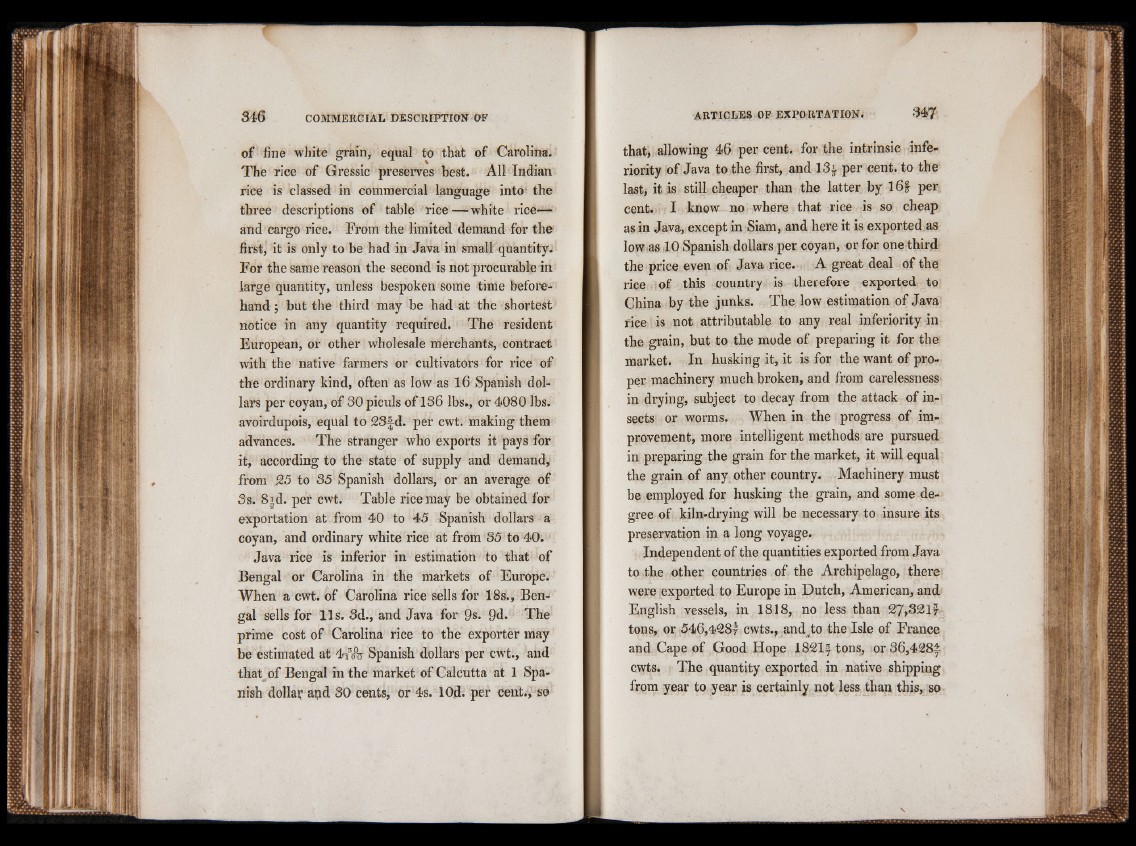
of fine white grain, equal to that of Carolina.
The rice of Gressic preserves best. All Indian
rice is classed in commercial language into1 the
three descriptions of table rice — white rice—
and cargo rice. From the limited demand for the
first, it is only to be had in Java in small quantity.
For the same reason the second is not procurable in
large quantity, unless bespoken some time beforehand
; but the third may be had at the shortest
notice in any quantity required. The resident
European, or other wholesale merchants, contract
with the native farmers or cultivators for rice of
the ordinary kind, often as low as 16 Spanish dollars
per coyan, of 30 piculs of 136 lbs., or 4080 lbs.
avoirdupois, equal to 2Sfd. per cwt. making them
advances. The stranger who exports it pays for
it, according to the state of supply and demand;
from 95 to 35 Spanish dollars, or an average of
3 s. 8 id. per cwt. Table rice may be obtained for
exportation at from 40 to 45 Spanish dollars a
coyan, and ordinary white rice at from 35 to 40.
Java rice is inferior in estimation to that of
Bengal or Carolina in the markets of Europe.
When a cwt. of Carolina rice sells for 18s., Bengal
sells for 1 1 s. 3d., and Java for 9s. 9d. The
prime cost of Carolina rice to the exporter may
be estimated at Spanish dollars per cwt., and
that of Bengal in the market of Calcutta at 1 Spanish
dollar and 30 cents, or 4s. 10,d. per cent., so
that, allowing 46 per cent, for the intrinsic inferiority
of Java to the first, and 13^ per cent, to the
last, it is still cheaper than the latter by l 6| per
cent. I know no where that rice is so cheap
as in Java, except in Siam, and here it is exported as
low as 10 Spanish dollars per coyan, or for one third
the price even of Java rice. A great deal of the
rice of this country is therefore exported to
China by the junks. The low estimation of Java
riee is not attributable to any real inferiority in
the grain, but to the mode of preparing it for the
market. In husking it, it is for the want of proper
machinery much broken, and from carelessness
in drying, subject to decay from the attack of insects
or worms. When in the progress of improvement,
more intelligent methods are pursued
in preparing the grain for the market, it will equal
the grain of any other country. Machinery must
be employed for husking the grain, and some degree
of kiln-drying will be necessary to insure its
preservation in a long voyage.
Independent of the quantities exported from Java
to the other countries of the Archipelago, there
were exported to Europe in Dutch, American, and
English vessels, in 1818, no less than 27>32lf-
tons, or 546,4^87 cwts., and jo the Isle of France
and Cape of Good Hope 1821ftons, or 36,428^
cwts. The quantity exported in native shipping
from year to year is certainly not less than this, so
\